ARTICLE EXPLAINING IF YOUR PALM TREE ACTUALLY HAS ANY VALUE
BE AWARE:
Only Rare Palm Trees Sell
Jungle Music Never Digs or Buys Them!
by Phil Bergman
Jungle Music Palms, Encinitas, CA
This article is about someone selling a palm tree that they own. If you want to BUY A LARGE PALM TREE, CLICK HERE
READ THESE HIGHLIGHTED ITEMS FIRST:
.png) If you have a palm you want to “sell”, read below and find out if your palm has any value. No one buys palms that have no value.
If you have a palm you want to “sell”, read below and find out if your palm has any value. No one buys palms that have no value.
.png) JUNGLE MUSIC NEVER BUYS NOR REMOVES LARGE PALM TREES FROM THE GARDEN. IF YOU HAVE A VERY RARE PALM, WE MAY HAVE A REFERRAL.
JUNGLE MUSIC NEVER BUYS NOR REMOVES LARGE PALM TREES FROM THE GARDEN. IF YOU HAVE A VERY RARE PALM, WE MAY HAVE A REFERRAL.
.png) Many palm trees die when they are dug and moved. Of palms that can be dug, the majority have no resale value, are not rare and therefore “diggers” won’t dig them.
Many palm trees die when they are dug and moved. Of palms that can be dug, the majority have no resale value, are not rare and therefore “diggers” won’t dig them.
.png) 98% of people that still call us have a palm with no value and no one will dig it. You are probably not “sitting on a gold mine”.
98% of people that still call us have a palm with no value and no one will dig it. You are probably not “sitting on a gold mine”.
Read below to determine your palms value and if it is rare. So, determine what you have and don’t contact us without reading this article!
Thank you.
Introduction to Someone Selling Their Palm Tree
About three or four times a week, I am contacted by people who want to sell a large palm from their garden. Typically they are people from somewhere in Southern California. Let me say at the onset, I am not in the business of buying, digging, and reselling large palms. On occasion I am involved in making referrals on large palm material, especially Howea forsteriana, the Kentia Palm, some Phoenix species and Jubaea. And, I will consider buying a collection of rare palms or cycads in containers, but presently I don’t really get involved in the moving of huge palms around Southern California. I am a nurseryman growing palms in containers. I grow palms that can be easily moved by people, not machines. We typically grow palms up to a 24 inch boxed size.
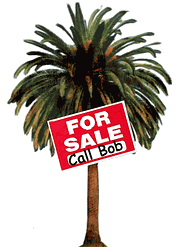
But, the emails and phone calls keep coming in. For whatever reason, people often want a palm removed from their garden. Typical reasons are its getting too big, I bought a house and I don’t like palms, or seeds are falling and making a mess. Sometimes people want a palm removed to enlarge their home. Sometimes people have been approached by a buyer knocking on their door. People contacting me also know another thing about palms: When they are large, they are expensive. Knowing this, they often think they are sitting on a gold mine. They, of course, would like to profit to some extent from their suspected bounty.
All these things are totally understandable. However, it is fact that some palms are sought after by the palm diggers, and others are not. Everyone has heard stories about someone selling a large Phoenix canariensis or reclinata for a pittance and the same palm being resold by the digger in Las Vegas for many thousands of dollars. This has created an almost urban legend about palms. It is true that this has happened. Realize that it will take thirty years or more for a nurseryman to grow and provide a Phoenix canariensis with thirty feet of trunk. No nurseryman will allow his stock to sit around for this amount of time. Therefore, such plants have to be dug from somewhere, typically someone’s private garden. The problem is that not all big palms are valuable. But a potential seller of a large palm from their garden hopes that they have one of these very valuable plants. To determine whether you have such a plant, there are things you must do.
First, Find Out What Species Of Palm You Have
You can do this by checking in a palm book or even going to the photo gallery at this website. If you continue reading below, perhaps some of the photos will help guide you. You can also call a local nursery and get one of their staff to come by to help you. If it is indeed a valuable palm, you might find they offer you something on the spot. Once you know the species of the palm you have, you can start to determine if it is indeed a valuable palm. Unless you yourself are a palm enthusiast or a previous owner of your house was one, don’t anticipate that you have an extremely rare palm. The majority of calls I get are for the Mexican Fan Palm or Queen Palm. The chances are that your palm is a common species and might not have much value. It can occur that someone randomly plants a rare and desirable species in your garden before you bought your house, but this is not the norm. Below I discuss the palms that are most likely palms seen in gardens around Southern California. If your palm is nowhere below, perhaps you have a unique or unusual palm. But usually the ones I’m called about are included herein. I must reiterate, try to find out what type of palm you have before you try to market it.
Is the palm accessible?
If a digger is interested in your palm, he plans to make a profit on selling it. If the extraction from your yard is overly costly, this subtracts from his profit. Therefore, plants near the street or easily accessible to digging equipment are more appealing to the digger. If it’s far in the back yard and on the other side of the pool with no easy access, he’s not going to be interested. It would have to be a very valuable plant for him to spend the money for such a removal. If the plant is near a building or structure where removal posts a risk to the structure, this is a deterrent to removal. Also, if there are overhead electrical lines overhead or nearby, most buyers will pass on your specimen. The risk of harm may be greater than the value of the tree.
Palms That Have Little or No Value For Resale
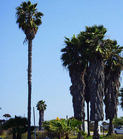
Washingtonia robusta
This species is the palm most people call me about as it is very commonly planted in Southern California. It often is planted along the parkways of streets. It is known as the Mexican Fan Palm. This species does dig nicely and survives with ease. Unfortunately this species has no resale value, even if it is really tall. No one will buy them! The problem is that the cost of the labor, crane, flatbed trucks and brokering of the plant is more than the sales price for the palm. The dollars for resale are basically not there. The best way to get rid of this palm is to place an ad that says free palm, you move. Let the person getting the palm arrange the digger, crane, etc. Such an arrangement is cheaper than having it professionally removed by a tree removal service. The chances are, however, that you will probably have to pay to have it removed. I have never had a digger remove one of these so please don’t call us if this is what you have!

Washingtonia filifera
Like its sister the W. robusta, these have very little value. Note that this species is much fatter in the trunk than the robusta. Perhaps they are more desirable than the robusta, but it will be difficult to sell for much of a profit if at all. Once again, if you can get it removed for free, you are the winner.
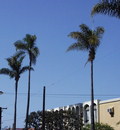
Syagrus romanzoffiana
The Queen Palm is certainly very popular. They are for sale at all the home improvement centers in Southern California. The problem is that they are quick growing and once again the numbers don’t work well for the professional digger. Essentially no palm re-locators who will buy a Queen. I haven’t seen one sold by a homeowner for 10 years! Queens cannot generate the sales price on resale that justifies the huge cost of digging and transporting. Remember that a 24 inch Queen planted in the ground is quite large in 5 to 10 years. This is another palm with no value. Please do not call us about Queen Palms!
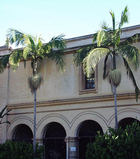
Archontophoenix species
This one is tricky. A large King palm, Archontophoenix cunninghamiana, may have value but the problem is that this genera does not dig well. This is well known in the industry. Your chances of a successful dig on a well established, large King Palm is less than 10%. There is the opinion that perhaps Archontophoenix alexandrae digs somewhat better, but most people do not have this species. Because of this problem, most diggers wont touch a King Palm.

Caryota
The problem with this genera is that, when moved, large Fishtail Palms can be thrown into blossom. This presents a risk to the digger as he might have to replace the palm later. Remember that Caryotas are monocarpic. This means that a given trunk will die when it goes into blossom. A large Caryota urenscan be thrown into blossom and die merely from the stress of the move. Therefore, the buyer of such a moved single trunk Fishtail may only enjoy his palm for a few years before blossoming begins and the leaves deteriorate. This phenomena is often not known by diggers, who will vigorously promise a long life to the buyer of a transplanted Fishtail. This problem also might not be seen on a relatively small specimen. For the suckering species, Caryota mitis, there are other trunks coming along. Therefore, it might have some value to the digger. However, for a large, single trunk variety the risk is great. In my many years as a grower, I have observed the remorse of a buyer who lost his big beautiful Caryota several years after a large one was, at great expense, placed into his garden.
Palms That Have Some Resale Value
But, Diggers Won’t Make You Rich!
Perhaps it’s better than nothing
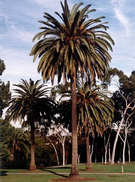
Phoenix canariensis
This species, the Canary Palm, has resale value because it takes so long to get a big specimen. What diggers and buyers want is a plant that you can walk below and not get hit by the spines on the leaves. Therefore, plants with less than 8 feet of trunk are not really sought after by the growers. Ten to twenty feet of trunk is what they prefer. An extremely large specimen with 40 or more feet of trunk might actually have less value because of the difficulty in transporting it on the roads. This species is often used in commercial locations, hotels, large office buildings, etc. Phoenix canariensis is the most common palm where someone unannounced knocks on your door and offers to buy your plant. Because of the arborists habit of tight pruning of the old leaf bases below the crown to form a “ball”, this species has recently become known as the “Pineapple Palm”. Although somewhat inappropriate as a name, this pruned specimen does seem to resemble a pineapple. Also, it does have somewhat wicked spines and, during work on this species, care must be used not to be poked by one of the spines. I get a lot of phone calls of people “checking out” the value of this species, as they are thinking of selling one. Please be aware that, if you are one of these potential sellers, your profit in trying to market a “Canary” will usually be a fraction of what a professional mover would receive for the same palm. This is simply because you are not the professional and you’re not offering any expertise about the palm. It doesn’t mean you can’t try to do it yourself, but don’t be disappointed if your “gold-mine” in not as profitable as you hoped.
Update Fall, 2014 and 2017: Because of diseases that this species gets, their value has plummeted and nowadays few diggers will even consider digging a Canary. Be prepared for a “no interest” attitude from landscapers.
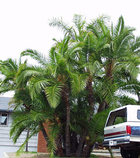
Phoenix reclinata
The same is true with this species. It is a suckering species often with many trunks. It can have real value if it is a very tall specimen. The trunks need to be way overhead to maximize its value. It can be dug successfully.

Phoenix dactylifera
The true Date Palm has had a recent surge in popularity and has some value, although less than the two above. It is typically single trunked in the garden although it can sucker. The limiting factor in its value is the fact that the date growers in the desert areas here are selling off some of their specimens at very reasonable prices. The supply is quite ample at this time, so the value of this species is sometimes less than expected.
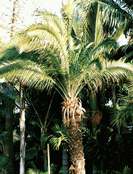
Other Phoenix species
Phoenix rupicola would be a sought after palm, although it is seldom seen around. The value of a well grown specimen of this species might be equivalent to a Phoenix canariensis. Phoenix roebellini likewise may have a little big of value, but it is so commonly available in stores that any value would be limited.
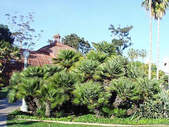
Chaemerops humilus
A well grown, large specimen of this can have value if the trunks are quite tall. Buyers typically look for a full, well balanced specimen of this species. Buyers also like it if the plant has a blue color to the leaves. To get a specimen over ten feet with multiple trunks takes well over ten to fifteen years (or longer) in the garden. Therefore, a large plant must be obtained by digging an established plant. If your specimen is more blue than green, this may add to it’s value.
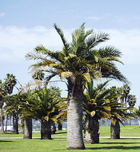
Jubaea chilensis
Now this is a very valuable plant, probably the best one that you could have. It is called the Chilean Wine Palm. If you have a big specimen of this, it is well worth your time to market it and get some value for it. Count your good fortune. There are very few of these around, so the price they go for is enormous. This means that you, the seller, should get multiple thousands of dollars for your mature specimen. This species is very slow to put on trunk. The largest palm to the left has been in the ground well over twenty years in Mission Bay Park in San Diego. If you have enough spare room on the back forty, this plant can be a great species to grow as an investment for your grandkids. It is slow growing but, in time, will create a great profit for someone. Be aware that less than 2% of the people who call me and tell me “I’ve got a Jubaea” actually have one – rather, they have a Canary Palm.

Howea forsteriana
The Kentia Palm, This elegant species does have value and is worth your time to market. It can be transplanted well, but on occasion I have known a very large specimen to die during the attempt. A huge specimen would be about thirty-five feet tall. Typical plants in full sun are thirty feet or less. Groupings of multiple plants together usually have more value.
Palms That May Have A Little Value
Included in this list are some palms that may have some value, but not much. You can probably get a mover to dig it and give you a few hundred dollars. But, they will not give you a huge profit nor will diggers break down your door to get them.
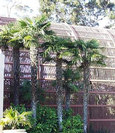
Trachycarpus fortunei
The Windmill palm can have a bit of value when it gets ten feet or more of trunk. You might get a few hundred dollars for a large plant.
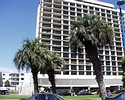
Butia capitata
The Jelly or Pindo Palm can likewise have some value. Large specimens are not real popular, but to the right purchaser there may be some money in it for the seller. To get tall, it takes decades. However, because of their lack of real popularity, the price they sell for is not too great.
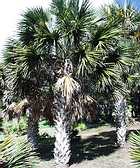
Sabal and Livistona
Species of these two genera are certainly around in Southern California. In the right circumstances, if a digger has a known buyer at the time, he might offer an owner a bit of money for one of these. However, he will not typically stockpile these species. Although not nearly as valuable as a Phoenix species, a nice specimen of one of these may bring you five hundred dollars, but more likely less. The most common Livistona is the Chinese Fan Palm, Livistona chinensis. A very old specimen of this species would have eight to ten feet of trunk.
Palms That Dig Poorly and Are Risky To Transplant

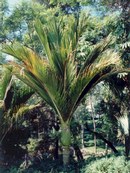
Brahea species (such as the Mexican Blue Fan Palm), Archontophoenix species (King Palm), and Rhopalostylis (Shaving Brush Palm) all do poorly with digging. Most crown shafted palms are known not to dig well. There is truth to the fact that in a tropical climate, Royal Palms (Roystonea) can be transplanted. My observation in Southern California is that a high percentage eventually succumb to a move. Some diggers are unaware of the problem with crownshafted palms and will try to dig them. But, as a buyer of a dug plant, be extremely cautious before spending big money on such a tree. If you are selling, typically a digger wont pay you much for these species.. I have seen two beautiful Rhopalostylis sapidas dug in a very professional manner and both died about two years later. Archontophoenix typically die right after digging. Brahea species, especially Brahea armata are high risk as well. They will die over a several month period. Special attention must be given to the cut roots of the root ball on the latter species as it is known that it will bleed to death after being dug. Even pulling up a potted plant that has rooted into the ground (and tearing these roots) can lead to a dramatic decline on this species.
Be Realistic If You Are Selling Your Palm
When selling a palm from your garden, be realistic about what the plant is actually worth and what a professional digger is likely to pay you. If you don’t like the price you are offered, you can call around and get competitive offers from multiple palm re-locaters. If you are still not satisfied, you can try to dig it yourself and market the plant yourself. This will prove to be quite a huge chore with both civil risks to you if something goes wrong as well as risk to the health of the tree. You definitely will need some type of liability insurance to protect yourself. Or, you could try to sell the palm with the buyer taking the responsibility of moving the palm. If you do the latter, make sure that he obtains the appropriate insurance to protect you and your home.
If all of this is too much to contemplate, then find an honest palm digger that your trust. Remember that he knows the value of the tree at resale and is in the business of making himself money, not making you money. Its unfortunate, but that’s the way it is with these fellows. You’ll get something, but he will get the lions share. If you can get one thousand dollars or more for any given palm, you are probably doing quite well. If you get a lot more for one plant, you are indeed a business person or dealing with a very fair palm digger. If your selling price is too high, he will probably just walk away. But, negotiation can work and don’t be afraid to try.
If You Decide To Sell Your Palm, Here’s What You Need To Know and Do
It is sad but true that there are a lot of unscrupulous and flaky guys out there that call themselves palm tree movers or palm re-locaters. There are also a lot of reputable people doing this work. You must decide if the person you are dealing with is honest and reliable. Ask for references from his previous clients on both sides of the transaction. Make sure he has a license to operate his crane. Make sure he is insured, bonded, and has workman’s compensation insurance on his workers. Moving large trees is not without risks to property and individuals. All these things are very important and proof of insurance, bonding, etc. must be provided to you. Make sure it is legitimate and current.
Also realize that the fellow that originally approached you to buy your palm might just be working on commission and have nothing to do with the actual moving of the palm. He might be what’s called a finder and paid if the deal goes through. Also ask for written and current proof of insurance and things mentioned above. And, very importantly, get the transaction in writing in the form of a contract! This should not only spell out the financial terms of the arrangement, but also the time frame of the digging. Diggers frequently like to put a plant under contract and let it sit in your yard until they have a buyer. They may attempt to pay you nothing until the plant is removed. In other words, they’re using your money until their buyer comes through. Only do this if it is OK with you. Agree on the time terms of the contract. If you don’t do this, the digger may take many moths or years to remove the plant. This may cause real problems with your plan for the garden once the palm was to be removed. And your contract can tie you up for a long time. Have a deadline by which the palm has to be removed or the digger forfeits the deposit or payment. Also, offer no guarantee on the palms survival. That is the problem of the digger.
You might consider having such a contract reviewed by an attorney, especially if you feel there is risk to your property of having the palm removed. In terms of payment, the best thing is to get your payment at the time of signing the contract. If you only take a deposit, make sure it is large enough such that, if the digger doesn’t perform, you would feel satisfied with the deposit. Also, make sure the contract spells out who’s responsible if sewer or water lines are broken, who fills in the hole with garden soil, and who does the cleanup. Perhaps the digger will put in a smaller palm to replace the one being removed. Think of all the things involved and protect your interests.
An Alternative: Consider Getting An Appraisal And Donating The Palm To A Charitable Institution
A final thought might be to hire someone to appraise your palm(s). This could be to make you feel comfortable with your selling price. But it might also give you a document for supporting a charitable donation. There are palm arborists around that do appraisals. If you know of a nonprofit organization such as a school, church, university, etc., you might want to consider donating the palm to them after you’ve gotten an appraisal done. This might qualify you for a taxable donation. You would need to have such a transaction reviewed by your tax accountant. It could work to your advantage because an appraisal will be much greater than any amount that a digger would pay you. You might even get a charitable organization to pay for the removal. Some people have found more satisfaction with this alternative and can visit and appreciate the palm from time to time in a local church or university.
COMMENTS OVER THE YEARS ABOUT SELLING YOUR PALM TREES:
This article has been posted for over fifteen years. Still, many times a week I get calls on palms that have no value and no one will dig. And, people think that we are people who dig palms! Why people call perplexes me. See updates below.
UPDATE February 2005
We are still not involved in the digging, moving, removal or selling of large palm trees in the ground. It is usually best to follow the advice given above if you have a large palm tree that you want to sell. If you have unusual cycads, by all means contact us. If you are located in the San Diego area and have a palm with some value as described above, feel free to email us with a photo and perhaps we can give you a referral. But, be realistic about the plant’s value. Good luck.
UPDATE December 28, 2006
We’ve had a lot of wind in the past 24 to 36 hours and I’ve had at least six or eight calls today from people wanting me to come and take away their tall Mexican Fan Palms. We are not a tree removal service nor do we buy large palms. Please contact us only if you have a palm that does have resale value (see above), and perhaps then I can give you a referral. Thank you.
UPDATE March 12, 2009
With the recent economic times, we are getting more and more calls from people trying to sell a large palm tree from their yard. I am reminding readers that, unless you live in the San Diego or Orange County area, we never get involved in the moving or selling of large palm trees. If you do live in our area, then perhaps I can give a referral. But, dug palms trees are not selling well now because of the economy.
UPDATE October 8, 2010
Remember that Queen Palms and Mexican Fan Palms essentially have no resale value and people in the tree moving business are NOT interested in them. I haven’t seen one purchased in almost ten years! But, I am still getting lots of calls from people wanting to sell these. Also, I get calls from people who think that “I” want them and will come and take them away. I don’t. I guess few people actually read; they just call. So, please read the article above before you contact us. If you are totally perplexed and can’t figure out what you have from the photos, send me a picture and perhaps I can advise you. Thanks.
Update Feb 5, 2011
People keep calling to see if “I” want to dig their Mexican Fans and take it away. I don’t! I am beginning to think people don’t read, but rather just look for a phone number. I am still getting five to ten calls a week about Mexican Fans.
Update Jan. 21, 2013
I’ve had three calls this morning alone for folks trying to sell Mexican Fan Palms. It’s a convincing testimony that people don’t read.
Update 2 September, 2013
Want to sell your large palm tree? We don’t buy them. Try a landscape contractor. Still 20 phone calls a week. Sort of humorous, isn’t it?
Update 18 Jan, 2014
Maybe there’s a bit less phone calls, but still a few a week about people wanting to know if I’ll remove their Mexican Fan Palms for free. Once again, we don’t dig palms. No one digs Mexican Fans, ever! But, if the economy improves some day, diggers may get back into digging palms with value. They’ll never dig Mexican Fan Palms!
Update 24 Jan, 2014
Because of ten calls a week, I’ve changed the title here to add “But We Don’t Buy Them“. I’ll see if it works.
Update 3 November, 2014
I’ve changed the title of this article again. Pretty plain and simple to me. I guess people just read the first line, not the second. By the way, the value of Canary Island Date Palms has plummeted. This is because of diseases that they frequently get. Many diggers won’t even consider digging them nowadays. It’s too much risk that they’ll get sick after being planted in a customer’s yard and those folks will want a refund. So, diggers just won’t do them any more.
Updated 28 January, 2016
Canary Island Palm values have plummeted. Diggers and growers are so afraid that they’ll die from disease that they fear they’ll get sued and lose their shirt if they dig or plant one. Almost entirely they’ve gone to the True Date Palm, Phoenix dactylifera. So, if you have a Canary, you probably missed your window. They might sell but only to landscape contractors “who have to have one”. Call them, not me. I have no referrals for you.
Updated May 27, 2016
Weekly I am still getting about ten to twenty calls from people that think I’ll remove their unwanted palm trees for free or that I want to buy them. The Saga continues….
Updated 26 November, 2017
Still getting ten to twenty calls a week about Queen Palms. Please don’t call me about them. No one will take them off your property.
Phil Bergman
- PALM TREES, CYCADS & TROPICAL PLANT BLOG - October 1, 2020
- TRACHYCARPUS
The Windmill Palm - September 30, 2020 - FAN PALMS –
PALMS WITH CIRCULAR LEAVES - September 29, 2020












